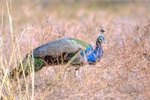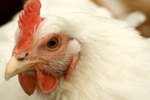
Mites not only cause discomfort for your bird, but they also can infest human habitations or other house pets. If left untreated, a mite infestation can result in beak deformity, anemia and possibly death, depending upon the type of mite causing the infestation. Treatment of the parrot, his environment and the home are needed for a successful resolution. A veterinary exam is always recommended if you suspect your bird has mites.
Sevin is the Lucky Number
One of the most popular, and most controversial, mite treatments is 5 percent Sevin dust. One of the mildest pesticides available, it has multiple applications both in the garden and in flea, lice and mite treatments on pets. It has been tested and approved for avian use, although there are those who prefer to avoid pesticides. When dusting your parrot, make sure to dust under the wings and tail, and avoid the head and face. Don't allow your parrot to inhale a cloud of Sevin dust, since it is a respiratory irritant. This product can be used to treat both the bird and the cage, and you can mix 1 teaspoon into nesting materials for use inside nesting boxes.
The Magic Flower
Pyrethrins, manufactured from chrysanthemum flowers and permethrin, made from daisies, provide an all-natural, mild pesticide you can use to treat your bird for mites, as well as his cage, perches and nesting boxes. Both come in liquid and powder forms, although permethrin will provide a longer period of protection for your parrot and is effective on all stages of mites, including eggs and nymphs, where pyrethrins is only active for a short period of time. If using a spray liquid, some parrot owners find it effective to spray a rag or towel with the pesticide then wrap the bird in the rag for a few minutes, gently rubbing the product into the feathers. As with Sevin dust, ensure the undersides of the wings receive treatment.
Internal Medicine
An avian veterinarian can administer oral or injectable medications that will treat your parrot's mites. Ivermectin, a popular dewormer for horses, has proven itself as an effective oral treatment for mites in parrots. In addition to killing mites, lice and flies, ivermectin also will rid your parrot of roundworms and blood parasites. Ivermectin's effectiveness is limited to killing mites that suck blood or skin scale, but will not kill quill mites. The most common method of oral administration of ivermectin is in your bird's drinking water.
Signs of Infestation
Mites may be visible to the naked eye as they crawl around on your bird's skin and feathers. The most common locations for mites are on the head and around the vent, although they can infect the entire body. Red mites, which are most common in outdoor birds, suck blood and are only active at night. If red mites are present on your bird, his most common symptom will be nighttime restlessness. Since red mites are nocturnal feeders, and they release themselves from their host after feeding, placing a white sheet on the bottom of the cage at night will collect the mites for a veterinary evaluation. These mites will appear like red or black pepper flakes. Scaly leg and face mites will leave a grayish-white, powdery, honeycomb-shaped substance on your bird's feet, legs and skin. You may see a ruffling of the feathers and he likely will engage in excessive preening.
References
Photo Credits
-
Jupiterimages/Photos.com/Getty Images



